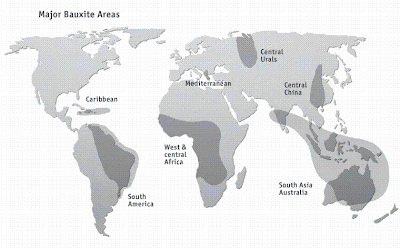Mount Toromocho, meaning "a bull without horns" in Spanish, is a mountain in the Junín Region, Peru that sits next to the long established mining camp of Morococha and hosts a large polymetallic metal deposit.
The entire majestic mountain is now owned by the Aluminum Corporation of China (Chinalco formerly Chalco) intended for a large open pit mine on the mountain and production of 210,000 tonnes copper annually.
One of the world's 10 largest
copper expansion projects
Toromocho contains a reserve of 1.526 Mt of ore with an average grade of copper of 0.48%.
Detonation on May 3, 2014.
The rock that fell near the carpentry workshop
left a ten-foot forrest on the floor.
Photo by Morococha Defense Front.
An example of an open pit mine.
Chuquicamata in Chile is one of the world's largest open pit copper mines.
By: Reinhard Jahn, Mannheim
In a couple of years, the entire majestic mountain is ready to go . . irreversibly and foremost by a strong demand for aluminum, the second largest metals market in the world.
These alloys are of vital importance in the construction of modern aircraft and rockets.
Copper is a ductile metal with very high thermal and electrical conductivity. Compounds that contain a carbon-copper bond are known as organocopper compounds.
***It is important to note the safe disposal of "Enargite" a copper arsenic sulfosalt mineral. Enargite are found in the copper mines of USA, Canada, Mexico, Argentina, Chile, Peru, and the Philippines.
Arsenic contamination of groundwater is a problem that affects millions of people across the world. When it finds it way to the food chain, in particular the oceans, then it will annihilate certain species of fish life if not all.
Now we are talking about an undetermined nearing extinction of Peruvian anchovy, or anchoveta. Three million tons of sardines (a year) were caught twenty years ago and NOT EVEN a ton can be captured these days.
Let us also be reminded that organoarsenic compounds, especially those featuring As-Cl bonds, have been used as chemical weapons, especially during World War I.
Pure aluminum is soft and lacks strength, but alloyed with small amounts of copper, magnesium, silicon, manganese,
or other elements impart a variety of useful properties.
These alloys are of vital importance in the construction of modern aircraft and rockets.
Copper is a ductile metal with very high thermal and electrical conductivity. Compounds that contain a carbon-copper bond are known as organocopper compounds.
***It is important to note the safe disposal of "Enargite" a copper arsenic sulfosalt mineral. Enargite are found in the copper mines of USA, Canada, Mexico, Argentina, Chile, Peru, and the Philippines.
Arsenic contamination of groundwater is a problem that affects millions of people across the world. When it finds it way to the food chain, in particular the oceans, then it will annihilate certain species of fish life if not all.
Now we are talking about an undetermined nearing extinction of Peruvian anchovy, or anchoveta. Three million tons of sardines (a year) were caught twenty years ago and NOT EVEN a ton can be captured these days.
Let us also be reminded that organoarsenic compounds, especially those featuring As-Cl bonds, have been used as chemical weapons, especially during World War I.
An example of an Acid mine drainage
affecting the stream running from the disused
Photographed by: Cls14
A stream in the town of Amlwch, Anglesey, Wales
Alcoa established an 8% stake in China's state-run aluminum industry and has formed a strategic alliance with Aluminium Corporation of China (Chalco), China's largest aluminum producer, at its Pingguo facility. Alcoa sold this stake on September 12, 2007.
Open-pit mines are typically enlarged until either the mineral resource is exhausted, or an increasing ratio of overburden to ore makes further mining uneconomic. When this occurs, the exhausted mines are sometimes converted to landfills for disposal of solid wastes. However, some form of water control is usually required to keep the mine pit from becoming a lake.
Other open pit mines for earth's precious minerals. .
A coquina quarry.
El Chino, located near Silver City, New Mexico, is an open-pit copper mine
Today the Big Ten aluminum manufacturers are:
Resources of bauxites, the raw material for aluminium, are not widespread throughout the world.
There are only seven bauxite-rich areas: Western and Central Africa (mostly, Guinea), South America (Brazil, Venezuela, Suriname), the Caribbean (Jamaica), Oceania and Southern Asia (Australia, India), China, the Mediterranean (Greece, Turkey) and the Urals (Russia).
The main deposits of high-quality bauxites with high aluminium content (not less than 50%), are already divided by the main players.
Other companies have to either buy alumina on the free-market — and wholly depend on price movements — or join forces with deposit owners.
Whoever owns resources owns the world . . .
Bauxite Mining in Forest Areas
The conservation of rain forests is a key concern often voiced with regard to bauxite mining.
However there are deep concerns on how …. the original flora and fauna of much of the land involved in bauxite mining is restored once mining operations have ceased.
For all forest areas used for bauxite mining, 80% is returned to native forests, the rest is replaced by agriculture, commercial forest, or recreational area, thereby making the area more productive for the local community.
So it really should not come as surprise on why there are landslides, flash floods of biblical proportions and questionable earth movement near and far from where heavy mining are undertaken.
Sources: Wikipedia,
http://www.mineralszone.com/minerals/bauxite.html
http://www.aluminiumleader.com/en/serious/industry/
http://fromd.blogspot.com email: voicefromdorient@yahoo.com







1 comment:
Your blog post is really helpful for my China Alumina Industry Research and Development.
Post a Comment